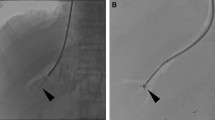Abstract
Diagnosis of acute rejection after liver transplantation is based mainly on clinical signs and the liver core biopsy findings. In this study we retrospectively analyzed our data on the routine use of fine-needle aspiration biopsy (FNAB) after 63 pediatric liver transplantations. A total of 824 FNABs was taken during the postoperative hospitalization, with a mean of 13 biopsies per patient. Forty-nine acute rejection episodes were diagnosed and treated after 39 transplantations (62%). The FNAB analysis detected rejections often before clinical signs. At the time of rejection diagnosis, fever was present in 38% of the patients, and serum bilirubin and alanine aminotransferase were elevated in only 19% and 13%, respectively. The rejections responded well to oral methylprednisolone, and lymphoglobulins were needed in only two episodes (4%). The results indicate that FNAB is a safe and sensitive method for the diagnosis and follow up of acute cellular rejection in pediatric liver recipients.
Similar content being viewed by others
Author information
Authors and Affiliations
Additional information
Electronic Publication
About this article
Cite this article
Their, M., Lautenschlager, I., von Willebrand, E. et al. The use of fine-needle aspiration biopsy in detection of acute rejection in children after liver transplantation. Transpl Int 15, 240–247 (2002). https://doi.org/10.1007/s00147-002-0401-5
Received:
Revised:
Accepted:
Published:
Issue Date:
DOI: https://doi.org/10.1007/s00147-002-0401-5




